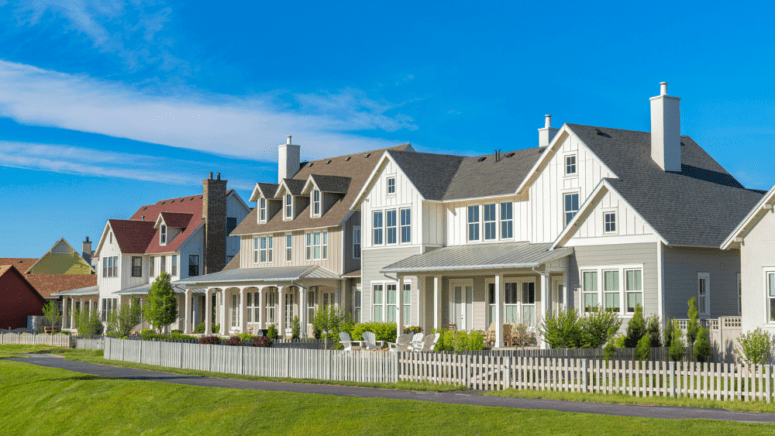Home Values in Utah: 2024 Market Trends and Insights
- Published on
- 12 min read
-
 Alexandra Lee Associate EditorClose
Alexandra Lee Associate EditorClose Alexandra Lee Associate Editor
Alexandra Lee Associate EditorAlexandra is an associate editor of HomeLight.com. Previously, she served as a writer and social media manager at Santa Barbara Life & Style Magazine, in addition to interning at the nonprofit honors society Phi Beta Kappa. Alexandra holds a bachelor's degree in communication and global studies from UC Santa Barbara, and she has three years of experience reporting on topics including international travel, luxury properties, celebrity interviews, fine dining, and more.
Interested in knowing more about home values in Utah? Whether you’re planning a move, hoping to cancel PMI, or simply tracking property trends in the Beehive State, having an accurate valuation of your home is the best way to inform your future plans.
In this guide, we’ll discuss current home price trends in Utah, show you how to obtain a precise home value estimate, and share simple yet effective strategies to enhance your property’s worth. Additionally, we’ll introduce tools to help you achieve the best possible price when you decide to sell your Utah home.
Editor’s note: This post is for educational purposes and is not intended to be construed as financial advice. HomeLight always encourages you to consult your own advisor.
Current home values in Utah
Since 2020, median home values in Utah have increased by an impressive 50.2%. At the beginning of the decade, the average home sold for $335,000, but by May of this year, that figure had risen to $509,900, as reported by the Utah Association of Realtors.
The state of Utah has seen one of the most significant housing price increases since 2020, with only a handful of other states climbing by 50%. Additionally, Utah has the youngest-aged population in the U.S., at a median age of 31.1 years.
“Population growth in Utah has traditionally come from childbirth, but for the last two years, 61 percent of our population growth came from job-related in-migration, and this is really straining the market,” said Dejan Eskic, senior research fellow at the University of Utah’s Kem C. Gardner Policy Institute, in a recent report by Utah Business.
He adds that housing affordability continues to worsen in the state, with thousands of new residential units and households needing to be built in the next several decades to keep up with population growth.
“There is so much pent-up demand for housing in Utah, this new supply we anticipate coming to market over a 10-or-more-year period will probably not move the needle much, if at all. And it gets worse because those who do decide to downsize are going to have their eyes on the same starter homes as these first-time homebuyers.”
The table below illustrates the sharp rise in Utah home prices over the last five years:
| Year | Median home price | Percent change year-over-year |
| 2024 (May) | $509,900 | + 3.8% |
| 2023 | $490,000 | – 9.3% |
| 2022 | $535,050 | + 23.0% |
| 2021 | $435,000 | + 29.9% |
| 2020 | $335,000 | + 4.3% |
Source: Utah Association of REALTORS
This trend isn’t unique to the Beehive State; it’s evident across the entire country. A quick glance at the S&P CoreLogic Case-Shiller National Home Price Index reveals that U.S. home prices have climbed by over 50% since the start of 2020.
This drastic increase has allowed homeowners to accumulate significant equity in their properties, which can be used for various financial opportunities such as purchasing new homes, renovating existing ones, saving for retirement, or investing in other ventures. According to ICE’s Mortgage Monitor report, as of early 2024, the average homeowner with a mortgage currently holds $299,000 in equity.
For comparison, the table below shows median home prices in several of Utah’s largest cities:
| City | Median home price | Population |
| Eagle Mountain | $509,900 | 61,037 |
| Ogden | $383,700 | 87,257 |
| Orem | $491,900 | 94,548 |
| Park City | $1,482,900 | 8,200 |
| Provo | $454,900 | 112,756 |
| Salt Lake City | $586,300 | 212,570 |
| Saratoga Springs | $515,800 | 57,278 |
| St. George | $504,400 | 102,519 |
| West Jordan | $530,100 | 114,200 |
| West Valley City | $469,300 | 132,635 |
Home values averages of multiple public transaction sites
Population estimates from World Population Review
In the following section, we’ll guide you through how to estimate the value of your Utah home.
How to get a home value estimate
If you’re hoping to figure out what your Utah home is worth, there are several tools available to help you. This can be useful whether you’re planning to sell and want to calculate your potential profit, or need assistance setting a fair listing price.
Use an online home value estimator
A quick and easy way to get an estimate for your house is to use an online home value estimator like HomeLight’s. These tools gather data from public records, like county tax assessor records, recent MLS sales, and user-submitted information, to provide a ballpark figure. HomeLight’s free online tool stands out by asking seven personalized questions about your home’s features, offering a more tailored valuation. In just minutes, you’ll get a preliminary estimate to kickstart your home-selling process.
Request a comparative market analysis
Alternatively, you can request a comparative market analysis (CMA) from a local real estate agent in your Utah neighborhood for a more specific valuation. A CMA is a comprehensive report that compares your property to similar homes recently sold in your area. It takes into account factors such as the number of bedrooms and bathrooms, square footage, the home’s condition, and the overall location, providing a more in-depth look at your property than an online estimate alone.
CMA reports typically include charts, graphs, and photographs to paint a detailed market overview. Though some agents charge a small fee, many agents will prepare a CMA for free, especially if you plan to list your home with them. This can help give you a clearer understanding of your home’s market value and ensure that you don’t over- or under-price when it comes time to sell.
Planning to sell your home soon? HomeLight can connect you with top real estate agents in your Utah neighborhood. This free service matches you with up to three qualified agents from our vetted network of professionals in under two minutes. HomeLight’s data indicates that the top 5% of listing agents can sell homes for up to 10% more than the average agent, helping you get the best price for your home.
Get a pre-listing appraisal
While a comparative market analysis is typically accurate, in some cases, an appraisal for selling house may be necessary to obtain the most accurate home valuation. This is especially useful for homes that contain unique features, are set in a rural location, or sit on large plots of land. These factors can be difficult to compare to other properties, so a CMA may not be sufficient. Getting your house appraised provides a detailed analysis in which an appraiser physically comes to evaluate your home and its characteristics, helping to ensure that your asking price reflects the true market value.
Note that appraisals generally cost between $450 and $550, with potentially higher fees for more complex properties. Even if you do get a pre-listing appraisal, also keep in mind that the buyer’s lender will still require their own appraisal to determine the loan amount (if the buyer is financing their purchase).
How to increase the value of your Utah home
If you’re planning to sell your home in Utah and want to maximize its value, there are a few strategic updates that can help significantly boost your sale price.
Curb appeal: Enhancing your home’s curb appeal is one of the most important steps for attracting buyers — after all, the exterior is the first thing they’ll see. According to the National Association of Realtors, 92% of realtors recommend improving curb appeal before listing a property on the market. Manageable projects like power washing, mowing the lawn, adding fresh mulch, and repainting the front door can significantly boost your home’s first impression.
Strategic updates: Prioritize home improvements that offer the best return on investment. According to Zonda’s 2024 Cost vs. Value Report, replacing the garage door is the highest-valued home upgrade, recouping 194% of the costs. In addition, consider updating high-impact areas such as kitchens and bathrooms with new fixtures, lighting, hardware, and appliances to increase your home’s appeal.
Necessary fixes: Addressing repairs for your home’s essential systems is key to avoiding negative inspection results. Ensure that your roof, plumbing, electrical, HVAC, and safety features are in good working order before listing. Fixing these issues ahead of time can prevent buyer concerns or lower offers and enhance your home’s overall value on the market.
Decluttering and depersonalizing: Decluttering and depersonalizing are can’t-miss steps to create a clean canvas and help potential buyers envision themselves living in your space. One HomeLight survey revealed that decluttering can increase a home’s sale price by $8,000 or more. Also, focus on removing personal items (including family photos or any religious symbols) and excess furniture to make spaces feel more open and inviting.
Deep cleaning: A thorough deep cleaning can not only enhance your home’s appeal, but also boost its market value. A HomeLight survey of top real estate agents found that deep cleaning can add an average of $3,700 to a home’s value. In specific, focus on steam-cleaning carpets, scrubbing grout, and washing windows to brighten your home. Also, be sure to search for dust in hard-to-reach areas, like ceiling fans, vents, or baseboards.
Home staging: Finally, expert home staging can significantly increase your market value. According to HomeLight’s most recent Top Agent Insights report, professionally staged homes can sell for up to 13% more than their unstaged counterparts. Plus, 31% of agents agreed that home staging is “essential” in today’s market. Staging helps highlight your home’s best features and creates an inviting atmosphere for buyers.
How to buy before you sell in Utah
If you’ve been researching home values in Utah and are ready to move, HomeLight’s Buy Before You Sell (BBYS) program may be just what you need.
BBYS lets you access a percentage of your current home’s equity, enabling you to make a strong, non-contingent offer on a new property. If your home qualifies, this equity can be unlocked within 24 hours, with zero obligations or upfront fees. This arrangement allows you to buy your new home first and sell your old one afterward, avoiding the need to juggle two moves or live in a staged home.
HomeLight charges a flat fee of 2.4% of the sale price of your current home. If the home doesn’t sell within 90 days of closing on your new property, HomeLight will purchase it and continue efforts to sell it. After deducting any costs HomeLight incurs, all profits will be passed on to you.
Press play on the video below to learn more about HomeLight’s Buy Before You Sell program:
How to find a top agent in Utah
Maximizing your home’s selling price starts with selecting the right real estate agent. HomeLight’s agent matching service offers a straightforward, free way to connect with up to three top-performing agents in your Utah area in under two minutes. This service is also unbiased, basing your matches solely on an agent’s specialties, past sales, and local market knowledge.
A key factor to consider when looking at your matches is an agent’s sale-to-list ratio, which compares the final sale price of a home to its original listing price. A high sale-to-list ratio indicates that the agent can price homes accurately and secure top dollar for their clients, making them a valuable asset for your home sale.
To make an informed decision, it is recommended to interview at least three agents before selecting one. Ask detailed questions to understand each agent’s experience and strategy, such as:
- How long have you been in business?
- How familiar are you with this neighborhood?
- What types of homes and price ranges do you typically handle?
- What’s your average time to sell a property?
- What is your commission fee?
- What marketing strategies would you use for my home?
- Can you provide references from past clients?
Using HomeLight’s agent match tool and these sample interview questions, you can confidently select a top real estate agent who will help you achieve the highest possible price for your home.
Get a free preliminary home estimate today
Understanding your home’s value is key to making informed decisions about your property, whether you’re preparing to sell soon or merely seeking a home equity loan. With HomeLight’s free home value estimator, you can get a quick and accurate ballpark figure for your home’s worth in just a few minutes.
HomeLight also offers services to connect you with top agents who can sell your Utah home for more, or enable you to buy a new house before selling your current one. By staying up to date on current Utah market trends and leveraging HomeLight’s handy tools, you can effectively maximize your home’s value with ease.
Header Image Source: Source: (dropthepress@gmail.com/ Depositphotos)
- "S&P CoreLogic Case-Shiller U.S. National Home Price Index," Federal Reserve Bank of St. Louis (June 2024)
- "Most REALTORS® Recommend Improving Curb Appeal, and Homeowners Can Benefit Financially and Emotionally by Remodeling Outdoor Features, NAR-NALP Report Finds," National Association of Realtors (March 2023)
- "Top Agent Insights for End of Year 2023," HomeLight (December 2023)
- " Top Agent Insights for Fall 2022," HomeLight (September 2022)
- "Top Agent Insights for Summer 2023," HomeLight (July 2023)
- "2023 Cost vs. Value Report," Zonda (March 2023)
- " February 2024 Mortgage Monitor," ICE Mortgage Technology (February 2024)
- "Local Market Updates by County", Utah Association of Realtors (May 2024)






